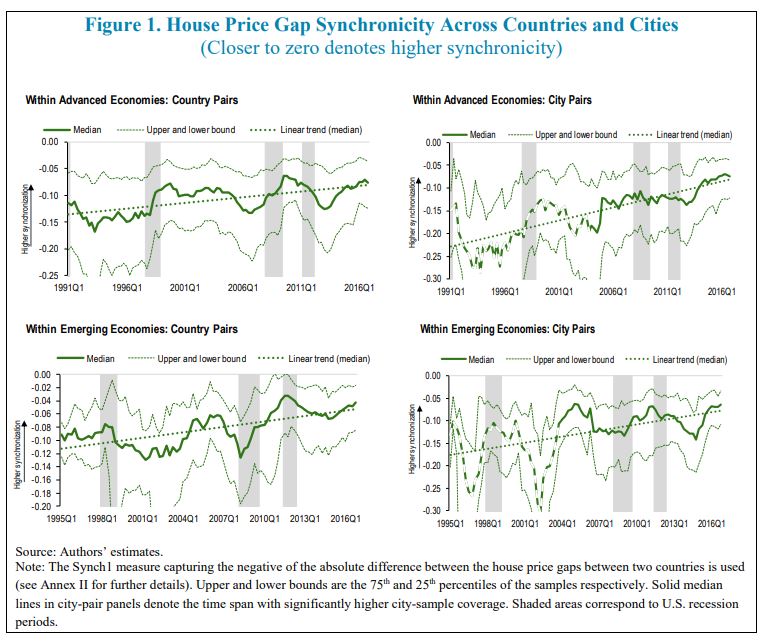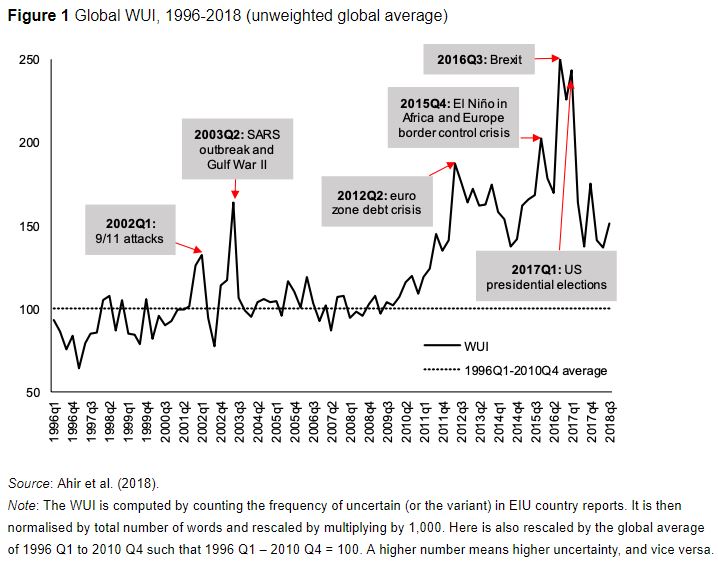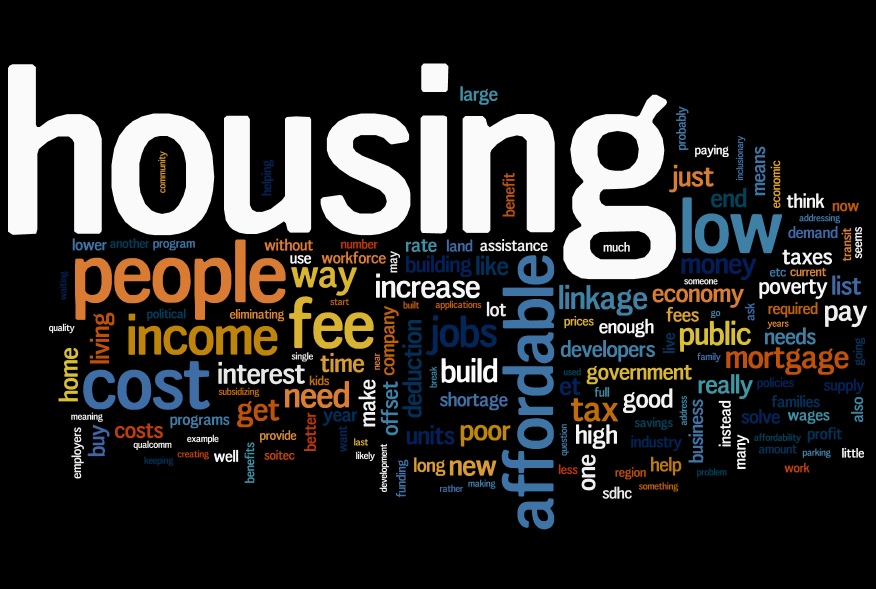Friday, November 30, 2018
House Price Synchronicity, Banking Integration, and Global Financial Conditions
From a new IMF working paper by Adrian Alter, Jane Dokko, and Dulani Seneviratne:
“We examine the relationship between house price synchronicity and global financial conditions across 40 countries and about 70 cities over the past three decades. The role played by cross-border banking flows in residential property markets is examined as well. Looser global financial conditions are associated with greater house price synchronicity, even after controlling for bilateral financial integration. Moreover, we find that synchronicity across major cities may differ from that of their respective countries’, perhaps due to the influence of global investors on local house price dynamics. Policy choices such as macroprudential tools and exchange rate flexibility appear to be relevant for mitigating the sensitivity of domestic housing markets to the rest of the world.”
From a new IMF working paper by Adrian Alter, Jane Dokko, and Dulani Seneviratne:
“We examine the relationship between house price synchronicity and global financial conditions across 40 countries and about 70 cities over the past three decades. The role played by cross-border banking flows in residential property markets is examined as well. Looser global financial conditions are associated with greater house price synchronicity, even after controlling for bilateral financial integration.
Posted by at 4:13 PM
Labels: Global Housing Watch
Finding Success
From the IMF’s Finance & Development magazine:
“Assaf Razin’s Israel and the World Economy shows that globalization can be a powerful force for economic progress in the case of a country with the institutions and policies to take advantage of the possibilities of an open economy. As depicted in this comprehensive and accessible book, Israel’s strong growth since its stabilization from high inflation in 1985 owes much to an international economy in which capital, labor, and ideas are mobile and in which trade and investment flow readily across far-flung international borders.
Razin explains that where other countries have experienced problems with globalization, Israel has found success. Large capital inflows are understandably viewed as dangerous in emerging markets living with memories of recent currency crises: in Israel foreign capital provided crucial funding for investment in the country’s showcase technology sector. Israel is now solidly established as a high-tech powerhouse—a place where budding venture capitalists from emerging market countries flock to learn how to develop an innovation ecosystem. But the domestic market alone is far too small and homegrown capital formation insufficient to foster that innovation. Globalization has been essential.
Similarly, immigration is a hot-button issue in the United States and in some countries in Europe but a source of growth in Israel. This is because a massive influx of skilled immigrants from the former Soviet Union starting in 1989 led to a surge in productivity, propelling Israel to medium- to high-income status, capped by membership in the Organisation for Economic Co-operation and Development in 2010. And Razin shows that this productivity boom translated into higher wages even for domestic workers who might otherwise have been harmed by the increased labor supply.
There is a sense in which this is three books in one. First, Razin explains the intuition and policy implications of a more globalized world across a range of topics, including migration, inequality, capital flows, currency crises, international trade, and more. The book then connects each topic to developments in the Israeli economy, portraying both successes and challenges in light of the underlying theory. Last, each chapter includes self-contained technical expositions of key models with which to analyze these economic phenomena, making this a text to be considered for a rigorous course on international economic policy.
It is not that Razin thinks Israel has done everything right—far from it. He covers rising inequality within Israeli society, the low participation rates and levels of skills among the fastest-growing segments of the population, the problem of brain drain as highly educated Israelis move abroad, and the costs associated with Israel’s security challenges, including a chapter on the “Rising Cost of Occupation.”
Still, even with Razin’s frankness about the potential pitfalls, his book is an ode to the potential benefits of good economic policy, to economic models through which to examine policy, and to Israel’s astonishing economic success.”
From the IMF’s Finance & Development magazine:
“Assaf Razin’s Israel and the World Economy shows that globalization can be a powerful force for economic progress in the case of a country with the institutions and policies to take advantage of the possibilities of an open economy. As depicted in this comprehensive and accessible book, Israel’s strong growth since its stabilization from high inflation in 1985 owes much to an international economy in which capital,
Posted by at 3:59 PM
Labels: Macro Demystified
Housing View – November 30, 2018
On cross-country:
- There is more to high house prices than constrained supply – Economist
- Pockets of risk in European housing markets – VoxEU
- The real cost of international real estate – Savills
- Rising residential costs help push Hong Kong to the top of the Savills Live/Work Index – Savills
On the US:
- Drivers of the Great Housing Boom-Bust: Credit Conditions, Beliefs, or Both? – NBER
- What The 1990s Tell Us About The Next Housing Bust – Real Estate Decoded
- Ruling mostly clears plan to upzone Seattle neighborhoods for affordable housing – Seattle Times
- A tax break to hasten gentrification? Housing market’s Opportunity Zones may miss their target – Market Watch
- US: Signs of a slowdown? – ING
- Ahead of Amazon’s move to Queens, could buying an apartment count as insider trading? – Quartz
- 81 Percent of Homes in the San Francisco Metro Area Are Worth More Than $1 Million. That’s Not Normal. – Reason
- The U.S. Housing Boom Is Coming to an End, Starting in Dallas – Wall Street Journal
- What Accounts for Recent Growth in Homeowner Households? – Harvard Joint Center for Housing Studies
- 6 ways Washington could make housing more affordable – Politico
- Why a housing project is building hope for the US working poor – Financial Times
- Rent Control Is Making a Comeback. But Is That a Good Idea? – The Pew Charitable Trusts
- House prices have surged, and so will the government’s mortgage obligations – Market Watch
- Why 2019 won’t lead to a home buyer’s market – Market Watch
- Black Homeowners Saw Greater Home Price Appreciation Than Whites in Some Areas – CityLab
- Secret luxury homes: how the ultra-rich hide their properties – Financial Times
On other countries:
- [Australia] Securitisation and the Housing Market – Reserve Bank of Australia
- [Australia] Why Australia may not be the next “big short” – MacroBusiness
- [China] China’s Real Estate Market – NBER
- [Ireland] Why are job numbers soaring despite the housing crisis? – The Irish Times
- [New Zealand] NZ cenbank to ease mortgage curbs but lift bank capital norms – Reuters
- [Puerto Rico] Generadores de 3700 dólares y lavabos de 666 dólares: los sobreprecios de las reparaciones en Puerto Rico – New York Times
- [Singapore] Financial Stability Review 2018 – Monetary Authority of Singapore
- [Sweden] Financial Stability Report 2018:02 – Sveriges Riksbank
- [Sweden] Swedish housing market starting to crumble – Variant Perception
- [United Kingdom] The case for scrapping stamp duty – Economist
- [United Kingdom] Lending relationships and the collateral channel – Bank of England
- [United Kingdom] Brexit effect ‘limited’ on UK house prices – Financial Times
- [United Kingdom] BOE Warns Disorderly Brexit May Halve Commercial-Property Prices – Bloomberg
Photo by Aliis Sinisalu
On cross-country:
- There is more to high house prices than constrained supply – Economist
- Pockets of risk in European housing markets – VoxEU
- The real cost of international real estate – Savills
- Rising residential costs help push Hong Kong to the top of the Savills Live/Work Index – Savills
On the US:
- Drivers of the Great Housing Boom-Bust: Credit Conditions,
Posted by at 5:00 AM
Labels: Global Housing Watch
Thursday, November 29, 2018
Global uncertainty is rising, and that is a bad omen for growth
From VoxEU:
“The global economy is growing, but so is uncertainty. This column presents a new quarterly index of uncertainty for 143 countries. The World Uncertainty Index reveals how uncertainty in the world has evolved over time, whether it is synchronised across countries, and how it compares across income groups and political regimes.
The October 2018 edition of the World Economic Outlook predicts that global economic growth will remain steady between 2018 and 2020 at the 2017 growth rate of 3.7% (IMF 2018). This exceeds the growth rate in any year between 2012 and 2016.
So, the global economy is growing, but so is uncertainty. Headlines that have appeared in the Financial Times in 2018 include: “Stocks unsettled by global trade uncertainty”, “Counting the costs of Brexit uncertainty”, “Latin America faces up to growing uncertainties”, “Italian bonds under pressure from budget uncertainty”, and “Boeing deal with Embraer faces political uncertainty”.
A Google news search for “uncertainty” gives about 0.6 million results for the whole of 2017, but 2.5 million results for the first ten months of 2018. Can we measure ‘uncertainty’ more precisely? Or compare the amount of ‘uncertainty’ in the US to that in China, the UK, or Ireland?
Measurements of economic and political uncertainty have been made only for a set of mostly advanced economies (Baker et al. 2016). We have constructed a new index of uncertainty for 143 countries using Economist Intelligence Unit (EIU) country reports. To the best of our knowledge, this is the first effort to construct a panel index of uncertainty for a large set of developed and developing countries.
Constructing the World Uncertainty Index
We constructed the World Uncertainty Index (WUI) – a quarterly index of uncertainty – for 143 individual countries from 1996 onwards. The WUI is defined using the frequency of the word ‘uncertainty’ (and its variants) in the quarterly EIU country reports. To make the WUI comparable across countries, the raw count is scaled by the total number of words in each report.
In contrast to existing measure of economic policy uncertainty, two factors help improve the comparability of the WUI across countries:
- The WUI is based on a single source. This source has specific topic coverage – economic and political developments.
- Reports follow a standardised process and structure.
The process through which the EIU country reports are produced helps to mitigate concerns about the accuracy, ideological bias, and consistency of the WUI. But we only have one EIU report per country per quarter, meaning there is potentially quite large sampling noise.
Stylised facts
This dataset allows us to establish five key facts:
1. Global uncertainty has increased significantly since 2012. Figure 1 shows that average uncertainty has increased since 2012, well above its historical average (computed between 1996 Q1 and 2010 Q4). The index spikes near the 9/11 attacks, the SARS outbreak, the second Gulf War, the euro area debt crisis, El Niño, the Europe border-control crisis, the UK referendum vote for Brexit, and the US presidential elections.
Interestingly, while text-based measures of uncertainty have been rising since the early 2000s, financial market measures rose until about 2010, but have fallen back to low levels (Pastor and Veronesi 2017).
Continue reading here.
From VoxEU:
“The global economy is growing, but so is uncertainty. This column presents a new quarterly index of uncertainty for 143 countries. The World Uncertainty Index reveals how uncertainty in the world has evolved over time, whether it is synchronised across countries, and how it compares across income groups and political regimes.
The October 2018 edition of the World Economic Outlook predicts that global economic growth will remain steady between 2018 and 2020 at the 2017 growth rate of 3.7% (IMF 2018).
Posted by at 10:46 AM
Labels: Macro Demystified
Tuesday, November 27, 2018
A Look Back At the Housing Stories of 2018
Below is a brief recap of the topics that the Global Housing Watch newsletter covered this year:
— Specific topics: affordable housing; housing policy; house prices and homeownership; surge in second home investments; understanding behavior of homebuyers; and urban revitalization.
— Summary of conferences and workshops: commercial and house price measurement; housing affordability; infrastructure and real estate; Housing, Household Debt and Policy; Housing, Urban Development, and the Macroeconomy; and Housing and Macroeconomics.
— Reading suggestions: summer reading list.
— Experts views on specific countries and regions: Africa, Latin America, Singapore, and United Kingdom.
— IMF assessments of housing markets. Regions: advanced economies, Europe, and cities. Countries: Australia, Austria, Belgium, Canada, Chile, China, Colombia, Czech Republic, Denmark, Estonia, Germany, Georgia, Hong Kong, Hungary, Iceland, Indonesia, Ireland, Israel, Korea, Latvia, Lithuania, Luxembourg, Malaysia, Malta, Mongolia, Namibia, Netherlands, New Zealand, Norway, Peru, Philippines, Portugal, Qatar, Romania, Singapore, Slovak Republic, Spain, Sri Lanka, Switzerland, Thailand, Tonga, United Kingdom, United States, and Vietnam.
Below is a brief recap of the topics that the Global Housing Watch newsletter covered this year:
— Specific topics: affordable housing; housing policy; house prices and homeownership; surge in second home investments; understanding behavior of homebuyers; and urban revitalization.
— Summary of conferences and workshops: commercial and house price measurement; housing affordability;
Posted by at 5:00 AM
Labels: Global Housing Watch
Subscribe to: Posts








